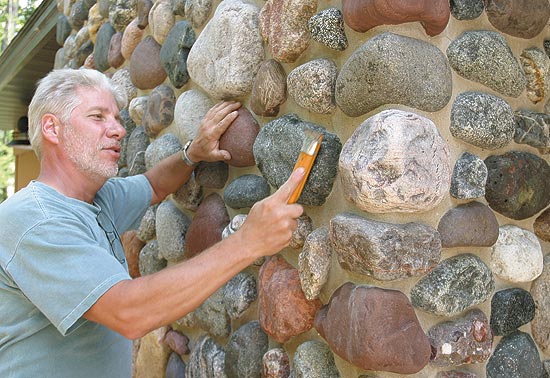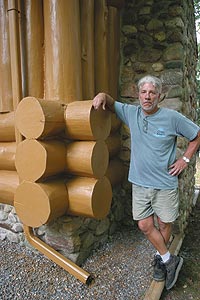Technician cares for Kemp Station

Gary Kellner, craftsworker and natural resources and maintenance technician at the Kemp Natural Resources Station in Woodruff, manages the day-to-day needs of the historic research station.
Kurt Krueger
It’s an unseasonably hot June day in northern Wisconsin and the sun is blazing, but the solitary figure working on the roof either doesn’t mind or is toughing it out.
The demanding manual labor, set against a backdrop of the scenic North Woods, makes a typical workday for Gary Kellner, craftsworker and natural resources and maintenance technician at the Kemp Natural Resources Station in Woodruff, Wis. The day-to-day needs of the historic research station add up to a rather unusual job description for this UW–Madison employee.
The self-described "token local" at Kemp — a native and resident of Sayner, Wis., just up the road — has done everything at the station from cutting grass and fixing roofs to replacing the chinking in the 80-year-old log buildings and renovating the former Kemp family carriage garages into laboratory space for visiting researchers.
"It’s never boring," Kellner says with a laugh. "I never do the same thing twice."
Evidence of Kellner’s creativity, talent and dedication is widespread across the station grounds, not least in his recent undertaking to finish the lower level of the newest building at the station, Mead Residence Hall. Though the residence hall was officially dedicated last July, the government contract included only the upper level of the building — leaving the task of finishing the lower floor to Kellner. After the better part of a year with just a few occasional helpers and his own two hands, Mead is nearly done and even boasts a brick patio and full deck.
The ground-floor plans also called for a stone fireplace and chimney to match the ones upstairs. With no previous masonry experience, Kellner volunteered to assist the contract mason on the upstairs fireplace, mixing mortar and handing him stones, and picking up tips along the way. During the winter, he independently completed the downstairs counterpart, a beautiful construction of multicolored lake stones that blends seamlessly with the upper.

Kellner
Despite the obvious care he takes with his work, he humbly dismisses praise of his accomplishments. "God made the rocks — I just put ’em up there," he says of his stonework. "I think anyone can do it, if you just stick with it."
A tour of Kemp Station with Kellner gives an insider’s view of the buildings and grounds. Where others might highlight the lab space and computer facilities, he points out intriguing details of the structural construction, such as the distinctive flared hemlock logs that form the corner posts of the old lodge, and the lodge windows and gazebo made of the storm doors that Edward Kemp’s company sold in the early 1900s.
This close attention to detail has helped him preserve the historic look of the old buildings even while maintaining and restoring them for 21st-century tasks. "It’s like ‘This Old House’ on a smaller scale," he says. Whether it’s developing a maple syrup operation to tap the resources of the station’s sugar maples or figuring out the best way to replace a single rotting log in the middle of a wall without disturbing the rest of the building, he’s sure to approach the task with a characteristic blend of hard work and humor. His secret? "Eyeball engineering," he replies, straight-faced.
Despite his full work schedule, Kellner takes the time to chat with researchers as they return to Kemp in the afternoons from their work off-site. He enjoys watching the students come and go and has met numerous deans and chancellors and even a couple of governors during the notables’ visits to what he jokingly calls "still the finest resort in the Minocqua chain."
After 14 years at Kemp, Kellner has a personal stake in every building at the station. He surveys the grounds with a visible sense of pride and ownership, then — break over — he’s off to work again.



